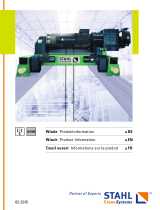
DEUTSCH
Sichere Verfahrensweisen zur Handhabung von Drahtseil
1. Bei der Handhabung von Drahtseil immer Handschuhe tragen.
2. Niemals ausgefranstes oder geknicktes Drahtseil verwenden.
3. Das Drahtseil niemals als Schlinge gebrauchen.
4. Stets sicherstellen, daß das Drahtseil richtig aufgespult ist und daß die erste Schicht fest an der Trommel anliegt.
Takelwerk
Sicherstellen, daß alle Drahtseilflaschen, Flaschenzüge und Befestigungsteile ausreichend zusätzliche Sicherheit bieten, um die erforderliche Last
unter allen Bedingungen handhaben zu können. Das Drahtseil nicht mit scharfen Kanten in Berührung kommen oder scharf geknickt werden lassen,
wodurch Beschädigung des Drahtseils eintreten könnte; eine Seilscheibe verwenden. Siehe das Handbuch des Drahtseilherstellers in bezug auf
Auswahl der richtigen Größe, Gebrauch und Pflege des Drahtseils.
Verfahren für sichere Installation
1. Das Drahtseil darf nicht als Erde (Masse) für Schweißverfahren verwendet werden.
2. Keine Schweißelektrode an die Winde oder das Drahtseil befestigen.
3. Das Drahtseil nicht über eine scharfe Kante laufen lassen, sondern eine Seilscheibe der richtigen Größe verwenden.
4. Wenn eine Führungsseilscheibe verwendet wird, muß sie mit der Mitte der Trommel ausgerichtet sein. Der Durchmesser der Führungsseilscheibe
muß mindestens das 18 fache vom Durchmesser des Drahtseils betragen.
5. Stets mindestens drei ganze Wicklungen Drahtseil auf der Trommel behalten.
Druckluftsystem
Die zugeführte Luft muß sauber, geschmiert und von Feuchtigkeit frei sein. Ein Mindestdruck von 6,3 bar/630 kPa am Windenmotor ist bei Betrieb
erforderlich, um die Nennleistung der Winde zu erreichen.
Druckluftleitungen
Der Innendurchmesser der Windendruckluftleitungen darf nicht kleiner sein als die Größen, die in dem Abschnitt “TECHNISCHE DATEN”
angegeben sind. Bevor die endgültigen Anschlüsse an den Windeneinlaß hergestellt werden, sind alle Luftzufuhrleitungen mit sauberer,
feuchtigkeitsfreier Luft oder Stickstoff auszublasen. Die Zufuhrleitungen sind so kurz und so gerade zu halten, wie es die Installationsbedingungen
erlauben. Lange Übertragungsleitungen und zu viele Anschlußstücke, Kniestücke/Schenkelrohre, T-Stücke, Kugelventile usw. verursachen eine
Druckverringerung aufgrund von Einschränkungen und Oberflächenreibung in den Leitungen.
Luftleitungstropföler
Bei diesen Motoren ist immer ein Luftleitungstropföler zu verwenden. Der Tropföler soll einen Ein- und Auslaß aufweisen, der zumindest so groß
ist wie der Windenmotoreinlaß. Der Luftleitungstropföler ist so nahe wie möglich am Lufteinlaß des Windenmotors zu installieren.
• Der Tropföler darf sich nicht mehr als 3 m vom Windenmotor entfernt befinden.
• Die Luftzufuhr ist zu unterbrechen, bevor der Luftleitungstropföler gefüllt wird.
Der Luftleitungstropföler ist täglich nachzufüllen.
1. Winden LS600R, PS1000R, LS1500R und PS2400R: Den Tropföler so einstellen, daß er 2 bis 3 Tropfen pro Minute liefert, wobei ein ISO VG
32 (10W) Öl (Mindestviskosität 135 Cst bei 40° C) zu verwenden ist.
2. Winden LS2000R, PS4000R, POWAIR35, LS5000R und PS10000R: Den Tropföler so einstellen, daß er 6 bis 8 Tropfen pro Minute liefert,
wobei ein ISO VG 32 (10W) Öl (Mindestviskosität 135 Cst bei 40° C) zu verwenden ist.
Luftleitungsfilter
Es wird empfohlen, ein Luftleitungssieb/-filter so nahe an der Motorlufteinlaßöffnung wie möglich, aber vor dem Tropföler zu installieren, um
Schmutz aus dem Ventil und dem Motor fernzuhalten. Das Sieb/Filter sollte eine Filterfeinheit von 20 Mikron aufweisen und eine Feuchtigkeitsfalle
enthalten. Das Sieb/Filter ist regelmäßig zu säubern, um dessen Wirksamkeit aufrechtzuerhalten.
Feuchtigkeit in den Luftleitungen
Feuchtigkeit, die durch die Luftleitungen in den Motor gelangt, ist bei der Bestimmung der Wartungsintervalle ein wichtiger Faktor. Feuchtigkeitsfallen
können dazu beitragen, Feuchtigkeit zu beseitigen. Andere Methoden, wie z.B. ein Luftsammelgefäß, das die Feuchtigkeit ansammelt, bevor sie an
den Motor gelangt, oder ein Nachkühler am Kompressor, der die Luft vor Verteilung durch die Zufuhrleitungen kühlt, sind auch nützlich.
Schalldämpfer
Sicherstellen, daß die Schalldämpfer in den Windenauslaßöffnungen installiert sind und richtig funktionieren.
Motor
Um optimale Leistung und maximale Lebensdauer der Teile zu gewährleisten, ist eine Luftzufuhr von 6,3 bar bei der im Abschnitt “TECHNISCHE
DATEN” angegebenen Strömung, am Motoreinlaß gemessen, vorzusehen. Die Winde ist so nahe wie möglich an dem Kompressor oder dem
Luftsammelgefäß zu installieren.
• Den angegebenen max. Betriebsdruck, 6,3 bar nicht übersteigen. Das Winden-überlastungsventil läßt Luft ab, falls der max. Druck
überstiegen wird.
Geräteüberprüfung vor Inbetriebnahme
Die Winden werden im Werk auf richtigen Betrieb geprüft. Bevor die Winde in Betrieb genommen wird, sind folgende Überprüfungsschritte
durchzuführen.
1. Wenn der Motor zum erstenmal in Betrieb genommen wird, ist eine kleine Menge leichtes Öl in den Einlaßanschluß einzuspritzen, um gute
Schmierung sicherzustellen.
2. Wenn die Winde zum erstenmal in Betrieb genommen wird, wird empfohlen, den Motor einige Minuten lang langsam in beide Richtungen laufen
zu lassen.
D-6


























